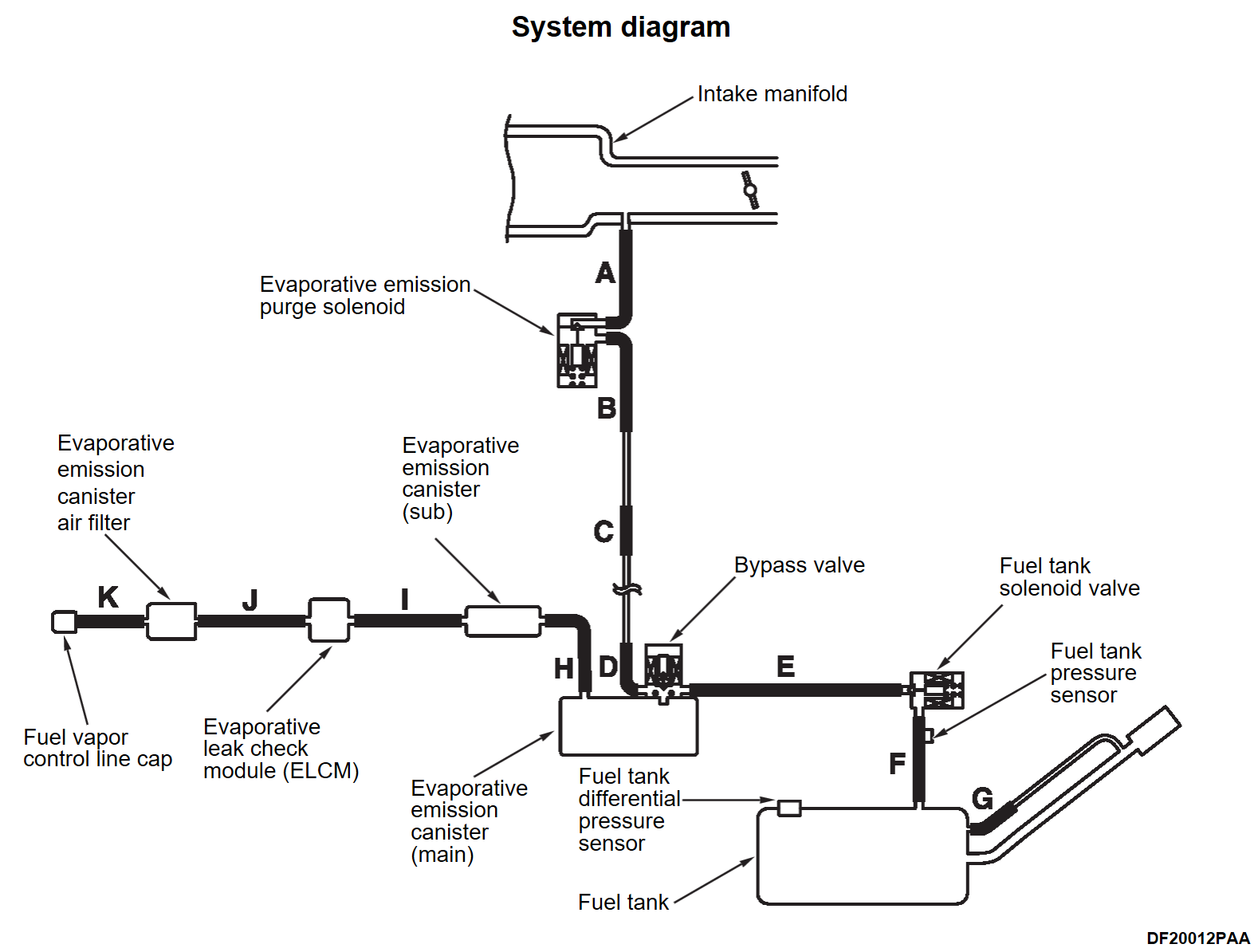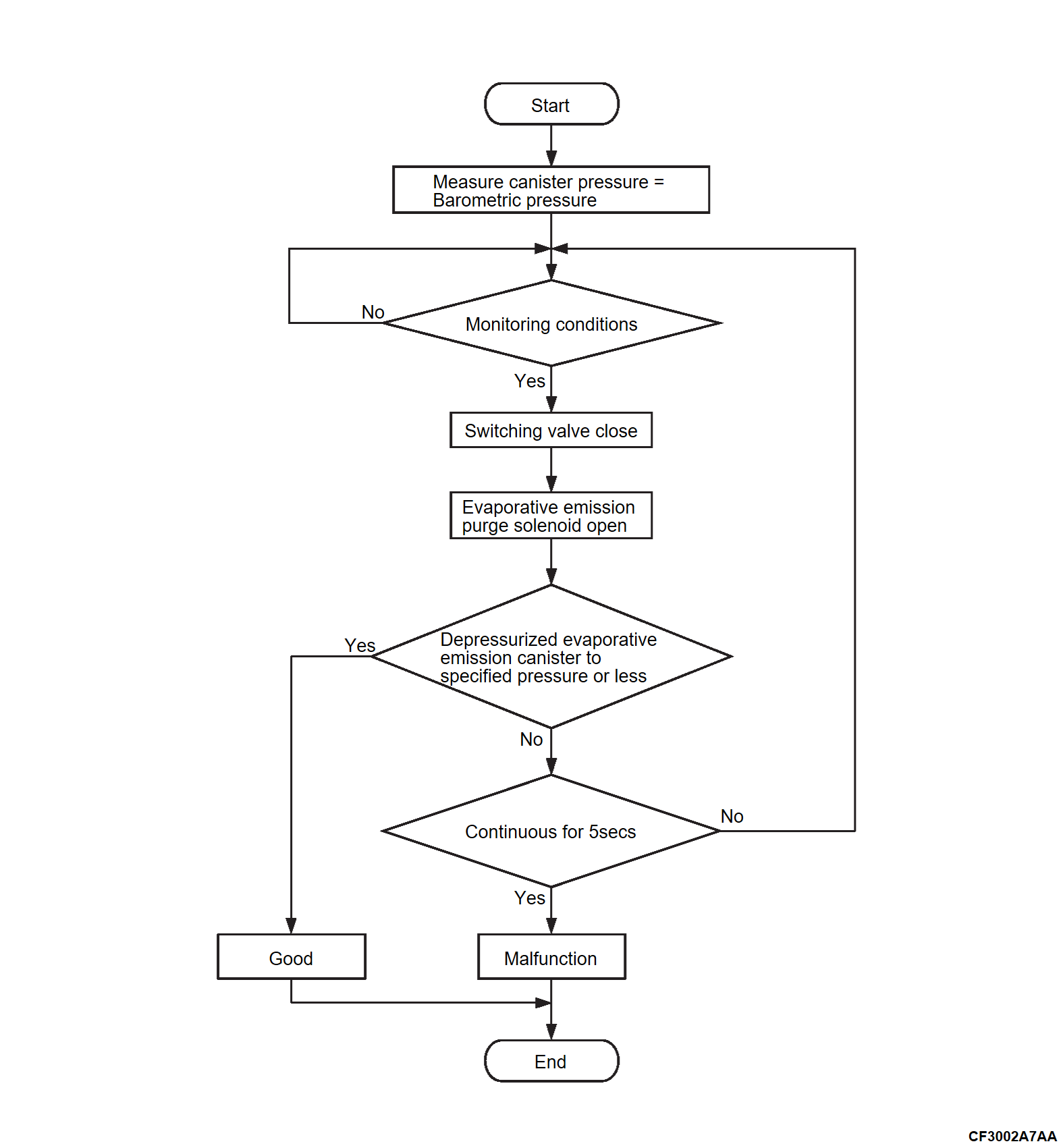DTC P0441-00: Evaporative emission control system incorrect purge flow
TECHNICAL DESCRIPTION
While the engine is running, close the switching valve built into the Evaporative Leak Check Module (ELCM), and detect the purge function failure from the pressure change in the evaporative emission canister when the purge is forcibly introduced by opening the evaporative emission purge solenoid.
MONITOR EXECUTION
Once per driving cycle.
MONITOR EXECUTION CONDITIONS (Other monitor and Sensor)
Other Monitor (There is no temporary DTC set in memory for the item monitored below)
- Barometric pressure sensor monitor
- Barometric pressure sensor/Manifold absolute pressure correlation
- Evaporative emission purge solenoid monitor
- Bypass valve monitor
- Fuel tank solenoid valve monitor
- Switching valve monitor
- Canister pressure sensor monitor
- Fuel tank pressure sensor monitor
Sensor (The sensor below is determined to be normal)
- Mass airflow sensor
- Engine coolant temperature sensor
- Intake air temperature sensor
- Barometric pressure sensor
- Throttle position sensor
- Manifold absolute pressure sensor
DTC SET CONDITIONS
Check Conditions
- Engine coolant temperature is higher than 20°C (68°F).
- Intake air temperature is higher than 5°C (41°F) and lower than 55°C (131°F).
- Mass airflow sensor output is 10 g/sec (0.35 oz./sec) or more.
- The ratio between the manifold absolute pressure and the barometric pressure is less than 0.96.
- The closed loop air-fuel control continues for 20 seconds or more.
- 12V battery positive voltage is 11.0 volts or higher.
- Engine is running.
- Bypass valve is not driving.
- More than 1 second has elapsed after the above mentioned conditions have been met.
- While engine is running, following condition is not even met once: intake air temperature is 5°C (41°F) or lower, or 55°C (131°F) or higher.
Judgment Criterion
- For 5 seconds, the canister pressure subtracted from the barometric pressure is less than 0.27 kPa (0.080 in.Hg) with the evaporative emission purge solenoid driving.
FAIL-SAFE AND BACKUP FUNCTION
- Fuel filler lid cannot be opened even when pressing the fuel filler lid opener switch.
- Prohibit introduction of purges.
OBD-II DRIVE CYCLE PATTERN
Refer to Diagnostic Function, OBD-II Drive Cycle – Pattern 2 OBD- II DRIVE CYCLE .
.
 .
.TROUBLESHOOTING HINTS (The most likely causes for this code to be set are:)
- Evaporative emission canister is clogged.
- Purge line seal failed.
- Purge line is clogged.
- Evaporative emission purge solenoid stuck closed.
- Bypass valve [built into the evaporative emission canister (main)] tuck closed.
- Fuel tank solenoid valve stuck open.
- Switching valve (built into the ELCM) stuck open.
- Canister pressure sensor (built into the ELCM) is stuck.
- Evaporative emission purge solenoid harness damage, or connector damage.
- ELCM circuit harness damage, or connector damage.
- ECM failed.
DIAGNOSIS
Required Special Tools:
- MB992744: Vehicle communication interface-Lite (V.C.I.-Lite)
- MB992745: V.C.I.-Lite main harness A
- MB992747: V.C.I.-Lite USB cable short
- MB992748: V.C.I.-Lite USB cable long
1.STEP 1. Check the evaporative emission purge solenoid for clogs.
Check the evaporative emission purge solenoid for stuck closed (Refer to ENGINE – Engine, Motor and Emission Control, Emission Control, Evaporative Emission System EVAPORATIVE EMISSION PURGE SOLENOID CHECK ).
). Replace the evaporative emission purge solenoid (Refer to ENGINE – Intake and Exhaust, Intake Manifold INTAKE MANIFOLD REMOVAL AND INSTALLATION
Replace the evaporative emission purge solenoid (Refer to ENGINE – Intake and Exhaust, Intake Manifold INTAKE MANIFOLD REMOVAL AND INSTALLATION ).
).
 ).
).Q: Is the check result normal?
 Replace the evaporative emission purge solenoid (Refer to ENGINE – Intake and Exhaust, Intake Manifold INTAKE MANIFOLD REMOVAL AND INSTALLATION
Replace the evaporative emission purge solenoid (Refer to ENGINE – Intake and Exhaust, Intake Manifold INTAKE MANIFOLD REMOVAL AND INSTALLATION ).
).2.STEP 2. Check the installation state of the vacuum hose, tube and pipe between the evaporative emission purge solenoid and fuel tank solenoid valve.
3.STEP 3. Check for leaks in hose A, hose B and hose C.
Use a hand vacuum pump to check hose A, hose B and hose C. Replace any damaged hose.
Replace any damaged hose.
Q: Do the hoses hold vacuum?
 Replace any damaged hose.
Replace any damaged hose.4.STEP 4. Check for leaks in tube D and Tube E.
Use a hand vacuum pump to check tube D and Tube E. Replace any damaged tube.
Replace any damaged tube.
Q: Do the tubes hold vacuum?
 Replace any damaged tube.
Replace any damaged tube.5.STEP 5. Check the fuel tank solenoid valve for leaks.
Check fuel tank solenoid valve itself (Refer to ENGINE, Engine, Motor and Emission Control – Emission Control – Evaporative Emission System FUEL TANK SOLENOID VALVE CHECK ).
). Replace the fuel tank solenoid valve (Refer to ENGINE, Engine, Motor and Emission Control – Emission Control – Evaporative Emission System FUEL TANK SOLENOID VALVE REPLACEMENT
Replace the fuel tank solenoid valve (Refer to ENGINE, Engine, Motor and Emission Control – Emission Control – Evaporative Emission System FUEL TANK SOLENOID VALVE REPLACEMENT ).
).
 ).
).Q: Does the fuel tank solenoid valve hold pressure?
 Replace the fuel tank solenoid valve (Refer to ENGINE, Engine, Motor and Emission Control – Emission Control – Evaporative Emission System FUEL TANK SOLENOID VALVE REPLACEMENT
Replace the fuel tank solenoid valve (Refer to ENGINE, Engine, Motor and Emission Control – Emission Control – Evaporative Emission System FUEL TANK SOLENOID VALVE REPLACEMENT ).
).6.STEP 6. Check harness between evaporative emission purge solenoid connector terminal number 1 and ECM connector terminal number 14.
Check output line for damage. Repair or replace the connector, or repair the damaged harness wire.
Repair or replace the connector, or repair the damaged harness wire.
Q: Is the check result normal?
 Repair or replace the connector, or repair the damaged harness wire.
Repair or replace the connector, or repair the damaged harness wire.7.STEP 7. Check harness between IPDM E/R connector terminal number 66 and evaporative emission purge solenoid connector terminal number 2.
Check power supply line for damage. Repair or replace the connector, or repair the damaged harness wire.
Repair or replace the connector, or repair the damaged harness wire.
Q: Is the check result normal?
 Repair or replace the connector, or repair the damaged harness wire.
Repair or replace the connector, or repair the damaged harness wire.8.STEP 8. Check harness between IPDM E/R connector terminal number 78 and ELCM connector terminal number 8.
Check power supply line for damage. Repair or replace the connector, or repair the damaged harness wire.
Repair or replace the connector, or repair the damaged harness wire.
Q: Is the check result normal?
 Repair or replace the connector, or repair the damaged harness wire.
Repair or replace the connector, or repair the damaged harness wire.9.STEP 9. Check harness between ELCM connector terminal number 4 and ECM connector terminal number 80, check harness between ELCM connector terminal number 5 and ECM connector terminal number 117, check harness between ELCM connector terminal number 6 and ECM connector terminal number 107, and check harness between ELCM connector terminal number 7 and ECM connector terminal number 97.
Check signal line for damage. Repair or replace the connector, or repair the damaged harness wire.
Repair or replace the connector, or repair the damaged harness wire.
Q: Are the check result normal?
 Repair or replace the connector, or repair the damaged harness wire.
Repair or replace the connector, or repair the damaged harness wire.10.STEP 10. Test the OBD-II drive cycle after replacing the evaporative emission canister (main).
After replacing the evaporative emission canister (main) and erasing the DTC, carry out test drive with the drive cycle pattern, and recheck the DTC. Replace the ECM (Refer to ENGINE CONTROL MODULE (ECM) REMOVAL AND INSTALLATION
Replace the ECM (Refer to ENGINE CONTROL MODULE (ECM) REMOVAL AND INSTALLATION ).
). The inspection is complete.
The inspection is complete.
(1) Replace the evaporative emission canister (main) (Refer to ENGINE – Engine, Motor and Emission Control, Emission Control, Evaporative Emission System EVAPORATIVE EMISSION CANISTER REMOVAL AND INSTALLATION ).
).
 ).
).(2) Use scan tool (M.U.T.-III SE) to erase the DTC.
(3) Carry out test drive with the drive cycle pattern (Refer to Diagnostic Function, OBD-II Drive Cycle – Pattern 2 OBD- II DRIVE CYCLE ).
).
 ).
).(4) Use scan tool (M.U.T.-III SE) to recheck the DTC.
Q: Is DTC P0441-00 set?
 Replace the ECM (Refer to ENGINE CONTROL MODULE (ECM) REMOVAL AND INSTALLATION
Replace the ECM (Refer to ENGINE CONTROL MODULE (ECM) REMOVAL AND INSTALLATION ).
). The inspection is complete.
The inspection is complete.![[Previous]](../../../buttons/fprev.png)
![[Next]](../../../buttons/fnext.png)

